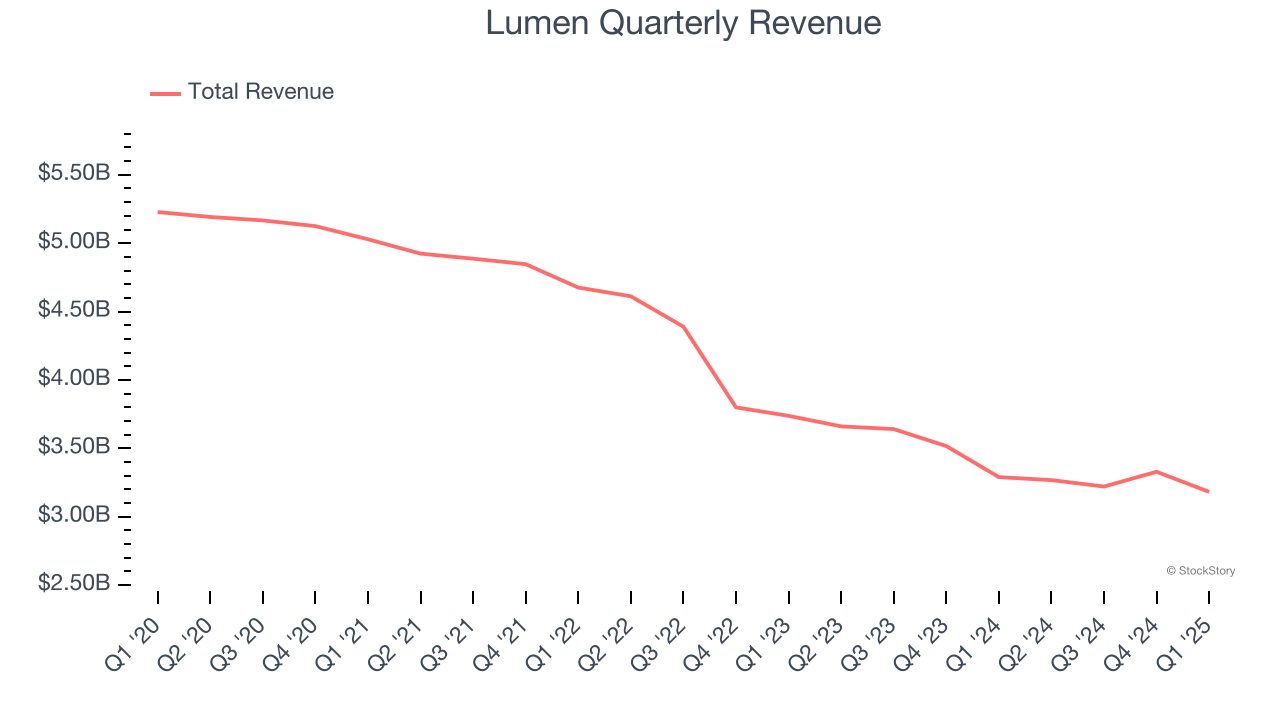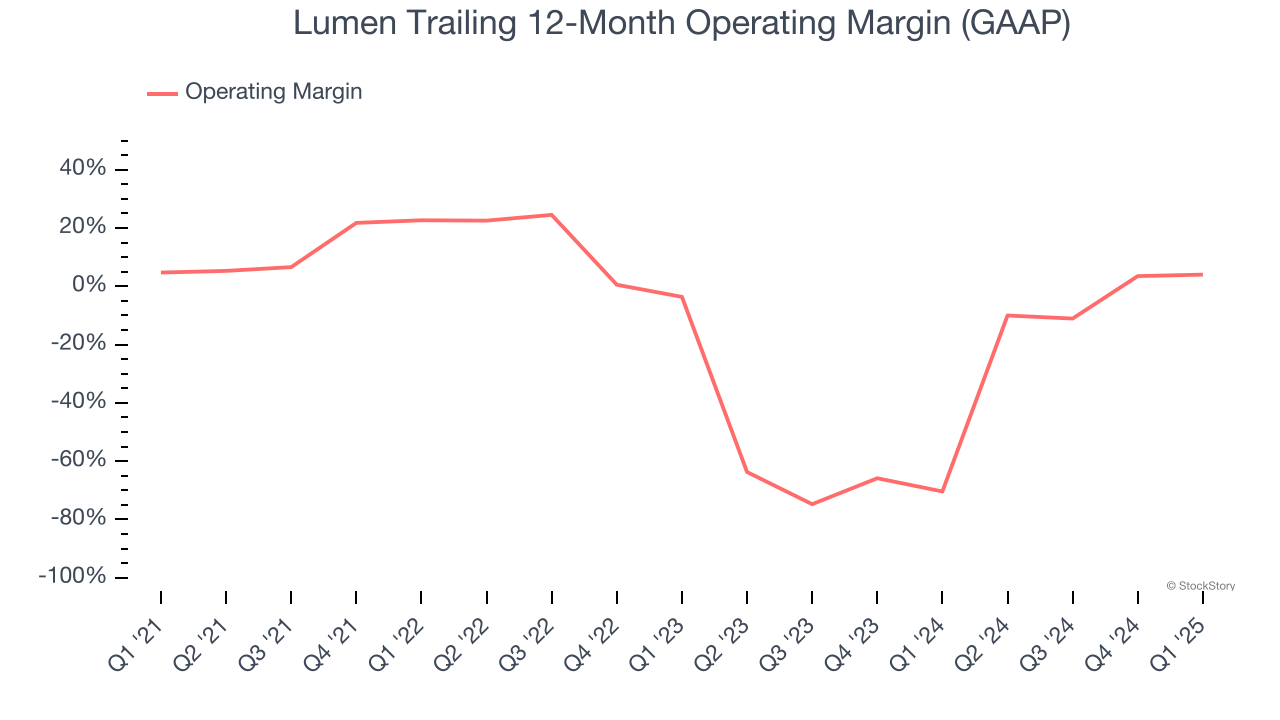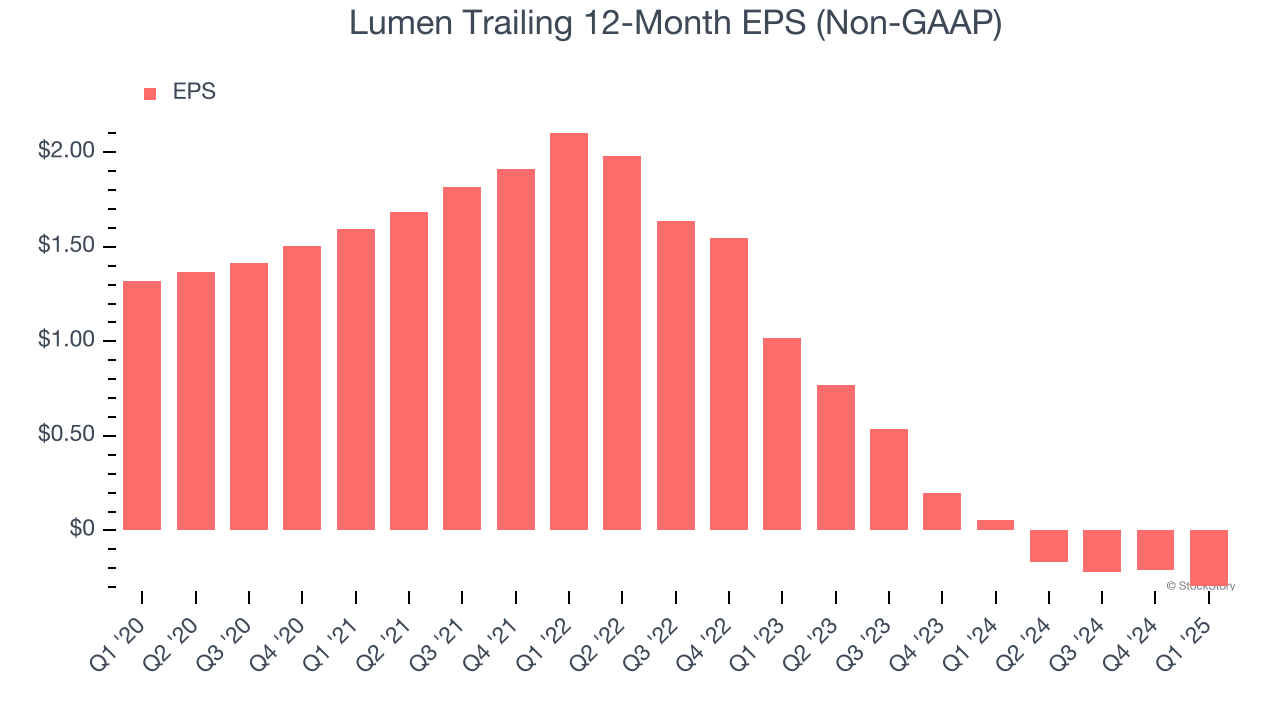
Telecommunications infrastructure company Lumen Technologies (NYSE:LUMN) reported Q1 CY2025 results topping the market’s revenue expectations, but sales fell by 3.3% year on year to $3.18 billion. Its non-GAAP loss of $0.13 per share was 51.2% above analysts’ consensus estimates.
Is now the time to buy Lumen? Find out by accessing our full research report, it’s free.
Lumen (LUMN) Q1 CY2025 Highlights:
- Revenue: $3.18 billion vs analyst estimates of $3.12 billion (3.3% year-on-year decline, 1.9% beat)
- Adjusted EPS: -$0.13 vs analyst estimates of -$0.27 (51.2% beat)
- Adjusted EBITDA: $929 million vs analyst estimates of $816.2 million (29.2% margin, 13.8% beat)
- EBITDA guidance for the full year is $3.3 billion at the midpoint, below analyst estimates of $3.33 billion
- Operating Margin: 3.4%, up from 1.4% in the same quarter last year
- Free Cash Flow Margin: 9.6%, down from 15.7% in the same quarter last year
- Market Capitalization: $3.59 billion
"The team's focus on operational excellence delivered better than expected financial results this quarter," said Kate Johnson, president and CEO of Lumen.
Company Overview
With approximately 350,000 route miles of fiber optic cable spanning North America and the Asia Pacific, Lumen Technologies (NYSE:LUMN) operates a vast fiber optic network that provides communications, cloud connectivity, security, and IT solutions to businesses and consumers.
Sales Growth
Examining a company’s long-term performance can provide clues about its quality. Any business can experience short-term success, but top-performing ones enjoy sustained growth for years.
With $13 billion in revenue over the past 12 months, Lumen is larger than most business services companies and benefits from economies of scale, enabling it to gain more leverage on its fixed costs than smaller competitors. This also gives it the flexibility to offer lower prices. However, its scale is a double-edged sword because finding new avenues for growth becomes difficult when you already have a substantial market presence. For Lumen to boost its sales, it likely needs to adjust its prices, launch new offerings, or lean into foreign markets.
As you can see below, Lumen’s demand was weak over the last five years. Its sales fell by 9.4% annually, a poor baseline for our analysis.

Long-term growth is the most important, but within business services, a half-decade historical view may miss new innovations or demand cycles. Lumen’s recent performance shows its demand remained suppressed as its revenue has declined by 11.3% annually over the last two years. 
We can dig further into the company’s revenue dynamics by analyzing its most important segment, Large Enterprise. Over the last two years, Lumen’s Large Enterprise revenue (services provided to businesses) averaged 6.9% year-on-year declines. This segment has outperformed its total sales during the same period, lifting the company’s performance.
This quarter, Lumen’s revenue fell by 3.3% year on year to $3.18 billion but beat Wall Street’s estimates by 1.9%.
Looking ahead, sell-side analysts expect revenue to decline by 6.2% over the next 12 months. Although this projection is better than its two-year trend, it's hard to get excited about a company that is struggling with demand.
Today’s young investors won’t have read the timeless lessons in Gorilla Game: Picking Winners In High Technology because it was written more than 20 years ago when Microsoft and Apple were first establishing their supremacy. But if we apply the same principles, then enterprise software stocks leveraging their own generative AI capabilities may well be the Gorillas of the future. So, in that spirit, we are excited to present our Special Free Report on a profitable, fast-growing enterprise software stock that is already riding the automation wave and looking to catch the generative AI next.
Operating Margin
Operating margin is an important measure of profitability as it shows the portion of revenue left after accounting for all core expenses – everything from the cost of goods sold to advertising and wages. It’s also useful for comparing profitability across companies with different levels of debt and tax rates because it excludes interest and taxes.
Although Lumen was profitable this quarter from an operational perspective, it’s generally struggled over a longer time period. Its expensive cost structure has contributed to an average operating margin of negative 5.6% over the last five years. Unprofitable business services companies require extra attention because they could get caught swimming naked when the tide goes out. It’s hard to trust that the business can endure a full cycle.
Analyzing the trend in its profitability, Lumen’s operating margin might fluctuated slightly but has generally stayed the same over the last five years, meaning it will take a fundamental shift in the business model to change.

This quarter, Lumen generated an operating profit margin of 3.4%, up 2 percentage points year on year. This increase was a welcome development, especially since its revenue fell, showing it was more efficient because it scaled down its expenses.
Earnings Per Share
We track the long-term change in earnings per share (EPS) for the same reason as long-term revenue growth. Compared to revenue, however, EPS highlights whether a company’s growth is profitable.
Sadly for Lumen, its EPS declined by 17.3% annually over the last five years, more than its revenue. This tells us the company struggled because its fixed cost base made it difficult to adjust to shrinking demand.

In Q1, Lumen reported EPS at negative $0.13, down from negative $0.04 in the same quarter last year. Despite falling year on year, this print easily cleared analysts’ estimates. Over the next 12 months, Wall Street expects Lumen to perform poorly. Analysts forecast its full-year EPS of negative $0.30 will tumble to negative $1.05.
Key Takeaways from Lumen’s Q1 Results
We were impressed by how significantly Lumen blew past analysts’ EPS expectations this quarter. We were also happy its revenue outperformed Wall Street’s estimates. Zooming out, we think this quarter featured some important positives. The stock traded up 1.1% to $3.56 immediately following the results.
Sure, Lumen had a solid quarter, but if we look at the bigger picture, is this stock a buy? When making that decision, it’s important to consider its valuation, business qualities, as well as what has happened in the latest quarter. We cover that in our actionable full research report which you can read here, it’s free.
